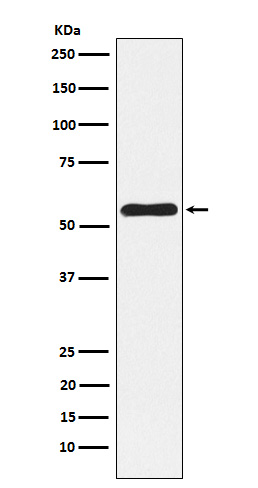NLK Antibody
Rabbit mAb
- SPECIFICATION
- CITATIONS
- PROTOCOLS
- BACKGROUND

Application
| WB, FC |
|---|---|
| Primary Accession | Q9UBE8 |
| Clonality | Monoclonal |
| Other Names | LAK1; Nemo like kinase; Nlk; |
| Isotype | Rabbit IgG |
| Host | Rabbit |
| Calculated MW | 58283 Da |
| Dilution | WB 1:500~1:2000 FC 1:50 |
|---|---|
| Purification | Affinity-chromatography |
| Immunogen | A synthesized peptide derived from human NLK |
| Description | Role in cell fate determination, required for differentiation of bone marrow stromal cells. Acts downstream of MAP3K7 and HIPK2 to negatively regulate the canonical Wnt/beta-catenin signaling pathway and the phosphorylation and destruction of the MYB transcription factor. |
| Storage Condition and Buffer | Rabbit IgG in phosphate buffered saline , pH 7.4, 150mM NaCl, 0.02% sodium azide and 50% glycerol. Store at +4°C short term. Store at -20°C long term. Avoid freeze / thaw cycle. |
| Name | NLK |
|---|---|
| Synonyms | LAK1 {ECO:0000312|EMBL:AAD56013.1} |
| Function | Serine/threonine-protein kinase that regulates a number of transcription factors with key roles in cell fate determination (PubMed:12482967, PubMed:14960582, PubMed:15004007, PubMed:15764709, PubMed:20061393, PubMed:20874444, PubMed:21454679). Positive effector of the non-canonical Wnt signaling pathway, acting downstream of WNT5A, MAP3K7/TAK1 and HIPK2 (PubMed:15004007, PubMed:15764709). Negative regulator of the canonical Wnt/beta-catenin signaling pathway (PubMed:12482967). Binds to and phosphorylates TCF7L2/TCF4 and LEF1, promoting the dissociation of the TCF7L2/LEF1/beta-catenin complex from DNA, as well as the ubiquitination and subsequent proteolysis of LEF1 (PubMed:21454679). Together these effects inhibit the transcriptional activation of canonical Wnt/beta-catenin target genes (PubMed:12482967, PubMed:21454679). Negative regulator of the Notch signaling pathway (PubMed:20118921). Binds to and phosphorylates NOTCH1, thereby preventing the formation of a transcriptionally active ternary complex of NOTCH1, RBPJ/RBPSUH and MAML1 (PubMed:20118921). Negative regulator of the MYB family of transcription factors (PubMed:15082531). Phosphorylation of MYB leads to its subsequent proteolysis while phosphorylation of MYBL1 and MYBL2 inhibits their interaction with the coactivator CREBBP (PubMed:15082531). Other transcription factors may also be inhibited by direct phosphorylation of CREBBP itself (PubMed:15082531). Acts downstream of IL6 and MAP3K7/TAK1 to phosphorylate STAT3, which is in turn required for activation of NLK by MAP3K7/TAK1 (PubMed:15004007, PubMed:15764709). Upon IL1B stimulus, cooperates with ATF5 to activate the transactivation activity of C/EBP subfamily members (PubMed:25512613). Phosphorylates ATF5 but also stabilizes ATF5 protein levels in a kinase-independent manner (PubMed:25512613). Acts as an inhibitor of the mTORC1 complex in response to osmotic stress by mediating phosphorylation of RPTOR, thereby preventing recruitment of the mTORC1 complex to lysosomes (PubMed:26588989). |
| Cellular Location | Nucleus {ECO:0000250|UniProtKB:O54949}. Cytoplasm {ECO:0000250|UniProtKB:O54949}. Note=Predominantly nuclear. A smaller fraction is cytoplasmic. {ECO:0000250|UniProtKB:O54949} |

Thousands of laboratories across the world have published research that depended on the performance of antibodies from Abcepta to advance their research. Check out links to articles that cite our products in major peer-reviewed journals, organized by research category.
info@abcepta.com, and receive a free "I Love Antibodies" mug.
Provided below are standard protocols that you may find useful for product applications.
If you have used an Abcepta product and would like to share how it has performed, please click on the "Submit Review" button and provide the requested information. Our staff will examine and post your review and contact you if needed.
If you have any additional inquiries please email technical services at tech@abcepta.com.













 Foundational characteristics of cancer include proliferation, angiogenesis, migration, evasion of apoptosis, and cellular immortality. Find key markers for these cellular processes and antibodies to detect them.
Foundational characteristics of cancer include proliferation, angiogenesis, migration, evasion of apoptosis, and cellular immortality. Find key markers for these cellular processes and antibodies to detect them. The SUMOplot™ Analysis Program predicts and scores sumoylation sites in your protein. SUMOylation is a post-translational modification involved in various cellular processes, such as nuclear-cytosolic transport, transcriptional regulation, apoptosis, protein stability, response to stress, and progression through the cell cycle.
The SUMOplot™ Analysis Program predicts and scores sumoylation sites in your protein. SUMOylation is a post-translational modification involved in various cellular processes, such as nuclear-cytosolic transport, transcriptional regulation, apoptosis, protein stability, response to stress, and progression through the cell cycle. The Autophagy Receptor Motif Plotter predicts and scores autophagy receptor binding sites in your protein. Identifying proteins connected to this pathway is critical to understanding the role of autophagy in physiological as well as pathological processes such as development, differentiation, neurodegenerative diseases, stress, infection, and cancer.
The Autophagy Receptor Motif Plotter predicts and scores autophagy receptor binding sites in your protein. Identifying proteins connected to this pathway is critical to understanding the role of autophagy in physiological as well as pathological processes such as development, differentiation, neurodegenerative diseases, stress, infection, and cancer.


